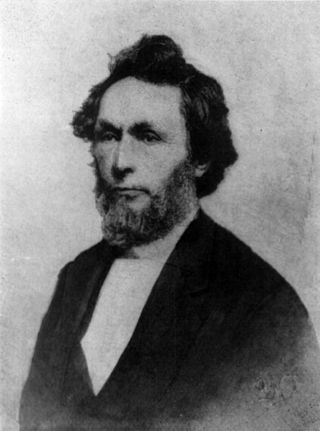
Abraham Lincoln was the 16th president of the United States, serving from 1861 until his assassination in 1865. He led the United States through the American Civil War, defending the nation as a constitutional union, defeating the Confederacy, playing a major role in the abolition of slavery, expanding the power of the federal government, and modernizing the U.S. economy.

Mary Ann Todd Lincoln served as the First Lady of the United States from 1861 until the assassination of her husband, President Abraham Lincoln, in 1865.

William Henry Bissell was the 11th Governor of the U.S. state of Illinois from 1857 until his death. He was one of the first successful Republican Party candidates in the U.S., winning the election of 1856 just two years after the founding of his party. In addition to being the first Republican governor of Illinois, he was also the first Catholic and also the first to die in office.

Ninian Edwards was an American political figure who was prominent in Illinois. He served as the first and only governor of the Illinois Territory from 1809 to until the territory earned statehood in 1818. He was then one of the first two United States senators from the State of Illinois from 1818 to 1824, and the third Governor of Illinois from 1826 to 1830. In a time and place where personal coalitions were more influential than parties, Edwards led one of the two main factions in frontier Illinois politics.

William Henry Herndon was a law partner and biographer of President Abraham Lincoln. He was an early member of the new Republican Party and was elected mayor of Springfield, Illinois.

Thomas Ford was a lawyer, judge, author and the eighth Governor of Illinois. The first Illinois governor to be raised in the state, he served from 1842 to 1846 and became known for restoring the state's solvency and reducing geographic sectionalism, as well as for leading the legislature despite his lack of prior political experience. A lifelong Democrat, Ford is also remembered for anti-Mormon sentiments and vacillation which led to the death of Joseph Smith, and the subsequent Illinois Mormon War of 1844-1845.

Edward Coles was an American abolitionist and politician, elected as the second Governor of Illinois. From an old Virginia family, Coles as a young man was a neighbor and associate of presidents Thomas Jefferson and James Monroe, as well as, secretary to President James Madison from 1810 to 1815.

Thomas Carlin, a farmer, soldier and Jacksonian Democrat, was the seventh Governor of Illinois and also served in both houses of the Illinois General Assembly. He became the first Democrat nominated at an Illinois state convention, as well as the last Illinois governor who fought Native Americans. His gubernatorial term was noted for its inconsistency, as he had limited financial experience and the state suffered the aftereffects of the Panic of 1837 as well attempted to fund a costly Internal Improvements Act passed by the state legislature over his predecessor's objections.
The history of Illinois may be defined by several broad historical periods, namely, the pre-Columbian period, the era of European exploration and colonization, its development as part of the American frontier, its early statehood period, growth in the 19th and 20th centuries, and contemporary Illinois of today.

The Government of Illinois, under Illinois' Constitution, has three branches of government: Executive, Legislative, and Judicial. The State's executive branch is split into several statewide elected offices, with the Governor as chief executive and head of state, and has numerous departments, agencies, boards and commissions. Legislative functions are granted to the General Assembly, a bicameral body consisting of the 118-member House of Representatives and the 59-member Senate. The judiciary is composed of the Supreme Court of Illinois and lower courts.

Richard Yates Jr. was the 22nd Governor of Illinois from 1901 to 1905—the first native-born governor of the state. From 1919 to 1933, he served in the U.S. House of Representatives from Illinois.

The Know Nothings were a nativist political movement in the United States in the 1850s, officially known as the Native American Party before 1855, and afterwards simply the American Party. Members of the movement were required to say "I know nothing" whenever they were asked about its specifics by outsiders, providing the group with its colloquial name.

Stapleton Crutchfield was a Confederate officer in the American Civil War closely associated with Stonewall Jackson until Jackson's death. Although Crutchfield lost a leg in the same battle, he returned to field in the last campaign in Virginia, losing his life in the Battle of Sailor's Creek.
The Illinois Department of Public Health (IDPH) is the code department of the Illinois state government that prevents and controls disease and injury, regulates medical practitioners, and promotes sanitation.

The 1830 Illinois gubernatorial election was the fourth quadrennial election for this office. Both candidates were Democrats and supporters of Andrew Jackson. State Representative John Reynolds was elected comfortably by a coalition of moderate Jacksonians and anti-Jacksonians, defeating the more radical Lt. Governor William Kinney.

The 1834 Illinois gubernatorial election was the fifth quadrennial election for this office. U.S. Representative Joseph Duncan was elected by a majority of the voters. He defeated former Lt. Governor William Kinney and former state treasurer Robert K. McLaughlin.

The 1842 Illinois gubernatorial election was the seventh quadrennial election for this office. Democrat Thomas Ford, who replaced the original Democratic nominee Adam W. Snyder following his death, defeated former Whig governor Joseph Duncan, who was running for a nonconsecutive second term.
Glenn V. Dawson is an American politician who served as a Democratic member of the Illinois House of Representatives from 1979–1980 and the Illinois Senate from 1980–1987.

The 1968 Indiana gubernatorial election was held on November 5, 1968.



















